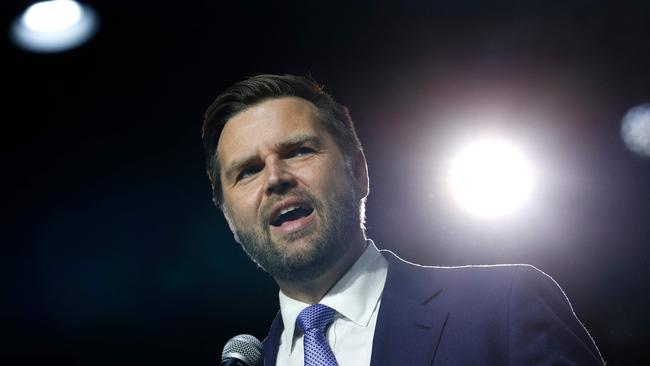Universities need to look closely at how they are perceived


The Universities are the Enemy is its unequivocal title, and it comes from a man whose arts degree from Ohio State and law degree from Yale were stepping stones in his journey from a dysfunctional, drug-ridden community in the post-industrial midwest to where he is now.
The anti-university feeling in Australia is not close to the level of sheer venom felt by Trump supporters in the US. But here it’s real enough, both at the level of the general population and in the political arena. Universities’ ability to directly influence political decision-making is minimal. The evidence is there in the casual ease with which the Albanese government has ransacked the international education industry this year without pushback from any political party. The fact that international education earned nearly $50bn in export revenue last year seemingly counted for nothing.
Yet Universities Australia has estimated that the government’s first action last December to restrict the issuance of student visas will cost universities $500m in revenue this year. If the government’s legislation for student caps passes parliament then universities and other international education providers will be hit with a second round of pain when Education Minister Jason Clare puts caps on student numbers with powers that enable him to control numbers down to course level and by geographic location.
How did universities arrive in this invidious position? There are two parts to the story. One is universities’ own blinkered journey to the precipice. The other is the lack of general awareness – both among the public and in political and business circles – as to what universities actually do and why it has importance.
Starting with the former: universities’ mishandling of their relationship with the public reached a peak in their handling of two issues.
One was vice-chancellors’ million-dollar salaries. University governing bodies, and vice-chancellors themselves, acted as if this issue – perceived by the public as an example of the gross indifference of the elites – didn’t matter.
But it did and does matter, and badly damages universities’ ability to be taken seriously by the public when they argue for more resources. Australian university leaders’ salaries are well above those in comparable countries. This was abundantly clear when Brian Schmidt, one of the few university leaders who have acted sensibly in this matter, became vice-chancellor of the Australian National University in 2016. He asked that his salary be pegged to international benchmarks and he accepted a package worth two-thirds the amount received by his predecessor. No other vice-chancellor is known to have followed his example.
There was another telling moment. When Michael Spence chose to leave the vice-chancellorship of the University of Sydney in 2020 to become head of University College London, a university of greater prestige, he halved his $1.5m salary package. What more needs to be said?
The other key issue on which universities have lost public trust is international students. For more than three decades they have been a growing source of revenue for most universities, filling the ever widening gap in research funding.
There has always been an underlying level of public disquiet about international students. There are fears that they take Australian students’ places – they don’t – and more well-founded evidence that too many international students have poor English skills and that some courses are overwhelmed by international students to the detriment of locals. Universities responded to this in the wrong way.
Yes they had a valid reasons to enrol international students. In reasonable numbers they enrich campus life and offer wider benefits to the nation by boosting exports and building strong ties in the region. But most universities reacted to the public disquiet by being secretive about how many international students were enrolled, how they were distributed across various degree courses, and how many came from each student source country.
In the absence of information, speculation and partial truths filled the gap. Parents heard only what their children told them about classes overcrowded with international students with poor English.
What if universities, 10 years ago, had collectively decided to put limits on the total number of international students (say at one-third of enrolments), and limited the proportion of international students enrolled in each course and the proportion from each source country? And then reported each year on these figures and also shared with the public more details of what they were doing to secure housing, part-time jobs and other necessities for international students?
If they had, they would be in a far better position to withstand the heavy pressure today to cut international student numbers. Such self-regulation would have required a revenue sacrifice from the big five universities – Melbourne, Monash, Queensland, NSW and particularly Sydney – which have benefited enormously from the wave of Chinese students coming to Australia. But it probably would have avoided the financial pain universities now are facing, let alone the damage being done to Australia’s reputation among international students.
But let’s be fair to universities. There really is a lack of appreciation of the importance of their role. Even those who buy the extreme Vance line that universities are so dangerously woke they pose a threat to Western civilisation (which I don’t) still have to acknowledge what universities do on a day-to-day basis. They make critical research breakthroughs, they invent new technology and they train the next generation of engineers, teachers, tech workers, nurses and specialists in countless disciplines that modern society is utterly dependent on. All of this has very little to do with woke students, freedom of speech controversies or disputes over Gaza and anti-Semitism.
I’ve come to the end of my nearly seven years as higher education editor at The Australian. It’s 21 years since I first covered the university sector and much has changed in that time. But universities are facing a more difficult outlook now than any I have seen.
What’s the solution? It’s up to universities to take a clear eyed look at what they do and how they do it. It’s not enough for them to cite their achievements. They need to look at their weaknesses and where the public isn’t buying their story.
And it’s up to the rest of us to acknowledge the critical benefits universities produce and ensure that they can continue.



Australia is not the only place in the world where universities are on the nose among a significant proportion of the population. For a sample of feeling in the US, see the speech by Republican vice-presidential candidate JD Vance that is getting new attention since Donald Trump chose him as his running mate.